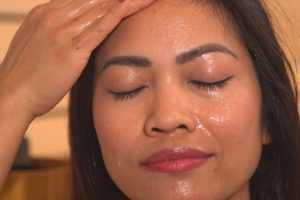Eczema is a skin condition characterised mainly by itchy, inflamed patches of skin. There are 7 types of eczema, with atopic dermatitis (AD) being the most common. Eczema is thus often used to refer to AD, with both the terms “Eczema” and “AD” being used interchangeably, as in this article. AD often begins before 5 years of age. Some people outgrow the condition, while others will continue to have it throughout adulthood, with periodic quiescence and flares.
The term “atopic” refers to an overreactive immune system which has heightened response to allergic triggers; research studies reveal that almost 80% of children suffering from AD (eczema) also develop asthma, and/or allergic rhinitis (hay fever), which constitute the atopic triad.
The effects of AD are more than skin-deep, impacting quality of sleep, social functioning, and psychological well-being. It is possible to alleviate symptoms with proper management.
How Eczema feels and looks like
Symptoms may vary from person to person, but commonly include:
- Dry, sensitive skin
- Pruritus or persistent itching
- Typical rash distribution
- Infants: scalp and cheeks
- Children and adults: behind knees, creases of elbow/inner elbow, wrists, ankles, between the buttocks and legs, nape of neck
- Open, weeping, or crusted sores
- Lichenification i.e. rough, leathery, or scaly patches of skin due to protracted scratching
- Inflamed, discoloured skin (e.g. brownish-gray patches)
The itch-scratch cycle is a hallmark of AD. Intense itch causes scratching, scratching causes further inflammation/irritation of the skin and more chemical mediators are released, which result in more itch. Damaged skin is also more susceptible to infection.
The stress and social embarrassment brought about by the skin condition may take a toll on the person’s self-esteem and have been linked with depression and anxiety. Severe symptoms affect sleep patterns, and together with release of inflammatory hormones, have also been associated with disrupted brain development in Attention Deficit Hypersensitivity Disorder (ADHD).
How is eczema acquired and diagnosed?
There is no single cause of eczema; it results from an interplay of
- Genetic predisposition
- Genes that cause skin dryness, reduction in skin barrier function
- Genes that promote hypersensitive immune system
- Environmental triggers
- Excessive bathing without moisturising skin after
- Low-humidity environments
- Emotional stress
- Overheating skin by going to a sauna or taking steaming hot showers
- Exposure to harsh chemicals such as detergents
- Exposure to allergens e.g. dust, pollen
Diagnosis is based on:
- Visual examination of the skin: Visible rash and inflammation are usually seen in areas around eyes, skin folds such as neck, back of the knees, and elbow pits
- Review of patient’s medical history
- When symptoms began
- Other concomitant atopic diseases
- Family history of atopic diseases
- Certain tests
-
- Patch testing may be done to reveal inhaled or food allergens
- Skin biopsy is sometimes done, helpful to rule out other skin conditions
General Treatment
- Identify and avoid triggers to avoid exacerbation e.g.
- Maintain cleanliness of the environment if dust is a trigger
- Wear cool, breathable clothing and limit activities that involve sweating
- Minimise stress
- Avoid food allergens e.g. eggs, soy, wheat, dairy, seafood as appropriate
- Use warm and not hot water during baths, with mild or soap-free cleansers.
- Moisturise skin twice daily
- Applying thick creams and ointments after baths helps to seal in moisture to prevent dryness of skin and itch. Lotions are an alternative for less greasy feeling.
- Using moisturiser first before medicated topicals helps the latter penetrate the skin better
- Topical anti-inflammatory treatment applied after moisturiser
- Corticosteroids e.g. hydrocortisone
- commonly associated with skin-thinning if high-potency formulations used for long periods
- Calcineurin inhibitors e.g. tacrolimus (Protopic®) and pimecrolimus (Elidel®), when corticosteroids fail to work or are unsuitable
- They are not associated with skin-thinning but some suggestion that it may increase risk of skin cancer
- Use for shortest period of time possible, and avoid exposure to sun
- Corticosteroids e.g. hydrocortisone
- Antibiotic for infected, open sores
- May be topical cream, or oral
For cases refractory to topical treatment
- Phototherapy
- Involves exposing the skin to controlled amounts of artificial ultraviolet A (UVA) and narrow band ultraviolet B (UVB) light
- May cause premature skin ageing and increased risk of skin cancer
- Not recommended for infants and children
- Systemic immunotherapy
- Works on immune system
- e.g. subcutaneously injected monoclonal antibody called dupilumab (Dupixent®).
Counselling
Talking to a counsellor may help in processing feelings of embarrassment, and frustration due to affected quality of life from loss of sleep and persistent itch.
Nutritional Alternatives
A lot of nutritional or dietary alternatives are being studied such as the use of probiotics, vitamins and fish oil intake, and plant-derived fatty acids. However, these complementary supplements do not obviate the need for first-line treatment such as topical corticosteroids.
Southeast Asian dermatologists advise against the use of alternative treatment due to the lack of evidence. In many developing countries, herbal remedies are used such as bath therapy, massage, health supplements, Chinese medicine, and topicals, in conjunction with pharmacologic treatments.
Conclusion
Although there is no cure for AD, appropriate treatment and self-care measures may help to relieve itch and keep symptoms under control, to enable sufferers to maintain quality of life.











